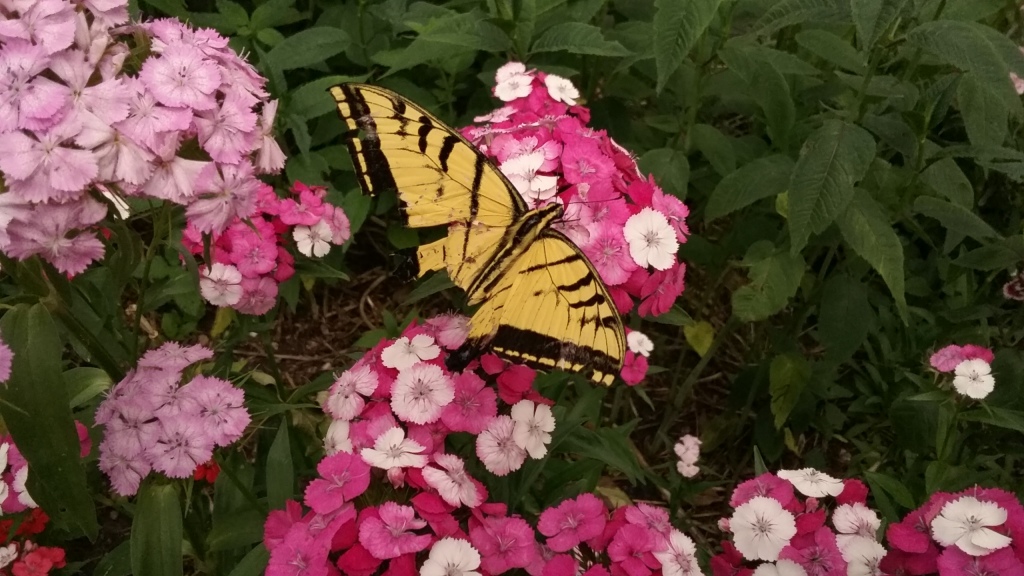
Published in the Wyoming Tribune Eagle July 4, 2020.
A weed by any other name can smell sweet
By Barb Gorges
“…a rose by any other name would smell as sweet?”
William Shakespeare
“A weed by any other name can be the exuberant flower you fell in love with and planted three years ago.”
Barb Gorges
There is no official horticultural definition of what a weed is. In everyday usage though, a weed is a plant out of place that is disrupting management goals.
This spring I realized my perennial flower beds needed renovation, weeding, editing, improving, whatever you want to call it—kind of a Marie Kondo tidying up. Volunteer sweet William (Dianthus barbatus) is taking over the herb bed. Even though me and the swallowtail butterflies love its multiple shades of pink, it is crowding out other plants and about to become a weed.
I rarely have traditional, ugly weeds like kochia or knotweed because they won’t find enough bare, sunny spots. (See “Advice for the weed-weary” below.) But because the beds were carved out of the lawn, grass is my biggest weed.
I learned an edging solution from Herb Schaal, the landscape architect for the Paul Smith Children’s Village at the Cheyenne Botanic Gardens. He has beautiful gardens and lawn in Bellevue, Colorado. Schaal digs a trench between lawn and garden about 6-8 inches wide and deeper than the grass roots grow. Then he fills the trench with mulch to keep people from breaking ankles and so that the lawn mower wheels can run on it and no edge trimming is required. He cleans roots out of the trenches once a year and refills them.
I’m trying the same technique here, but most my beds are already invaded by grass, like the yarrow patch. It may require digging up and trying to sort out the grass roots. Or I could start over, replacing it with a shovelful of uninfected yarrow from somewhere else in the yard.
Many of the plants in my perennial beds are gifts from plants or birds dropping seeds. Because individual perennial plants can’t last forever, I’ve learned to remove mulch in the spring and let unidentifiable seedlings grow up enough that I can tell whether they are friend or foe. I know that a columbine that sprouts on its own in a shady spot on pure clay left from construction will grow better than anything I can plant, other than another columbine.
Our mountain ash trees produce a plethora of seedlings every year. I pull them because otherwise they would become a forest. The trees were originally bird gifts, from fruit plucked from the tree across the street.
After months of winter dormancy, I realized oregano was taking over a bed. Why should I be surprised? It’s a mint and all mints have spreading reputations.

I vaguely remember a few years ago looking around for spare plants after enlarging this bed. The oregano in the herb bed needed thinning and bees like the flowers so I planted some along with another mint, bee balm (monarda or horsemint). But the oregano took over half the bed when I wasn’t looking and the bee balm was barely hanging on. Other plants were in hiding, hungering for water and sunlight which the oregano refused to share.
Maybe I should have harvested the oregano and dried it. Instead, I added most of it to the compost bin. The remainder standing in that bed will make green filler, and later, cut flowers, for bouquets this summer.

Then there are the hollyhocks. Years ago, I tried to grow them in the alley, but a neighbor mistook the first year’s leaf rosettes for weeds and mowed them while trying to be neighborly. I then encouraged hollyhocks to grow elsewhere and this year they are finally forming a herd. But then I realized they had surrounded my hardly-ever-blooming peonies. So, I moved a few hollyhocks and discovered how vigorous their root systems are. We will see next year if the peonies appreciate less competition.
There’s a saying about transplanted perennial plants, “The first year they sleep, the second year they creep and the third year they leap.” This is the third year for cutleaf coneflowers given to me by a friend thinning her garden. They seem to be living by that maxim’s timeline so I may have some to share with other friends next year.
My new weed philosophy: Sometimes you must take a shovel to plants before they become weeds.

Advice for the weed-weary
For those of you with traditional weeds, especially in a vegetable or annual flower garden, my advice is don’t till or hoe the soil because it will cause more weed seeds to germinate.
Mulch well, but not up against the stems of your plants and only with clean mulch that has no weed seeds. Use grass clippings, last year’s tree leaves or straw or wood chips if you have to (not the dyed ones).
Look for weed seedlings once a week or more often and pull them gently and steadily by hand to try to get the whole root and disturb the soil as little as possible. It helps to water the garden beforehand. Never let weeds go to seed.
There is a time and place for herbicides, such as a serious infestation of thistle or bindweed where deep roots are impossible to remove completely and tilling just multiplies them.
Herbicides (even “organic” or “natural” ones) are rarely needed at the city residential property level. Herbicides should never be applied to try to prevent weeds that may show up in the future, such as a “weed and feed” lawn care mix, because they just poison the watershed as they are washed away—and waste your money.





